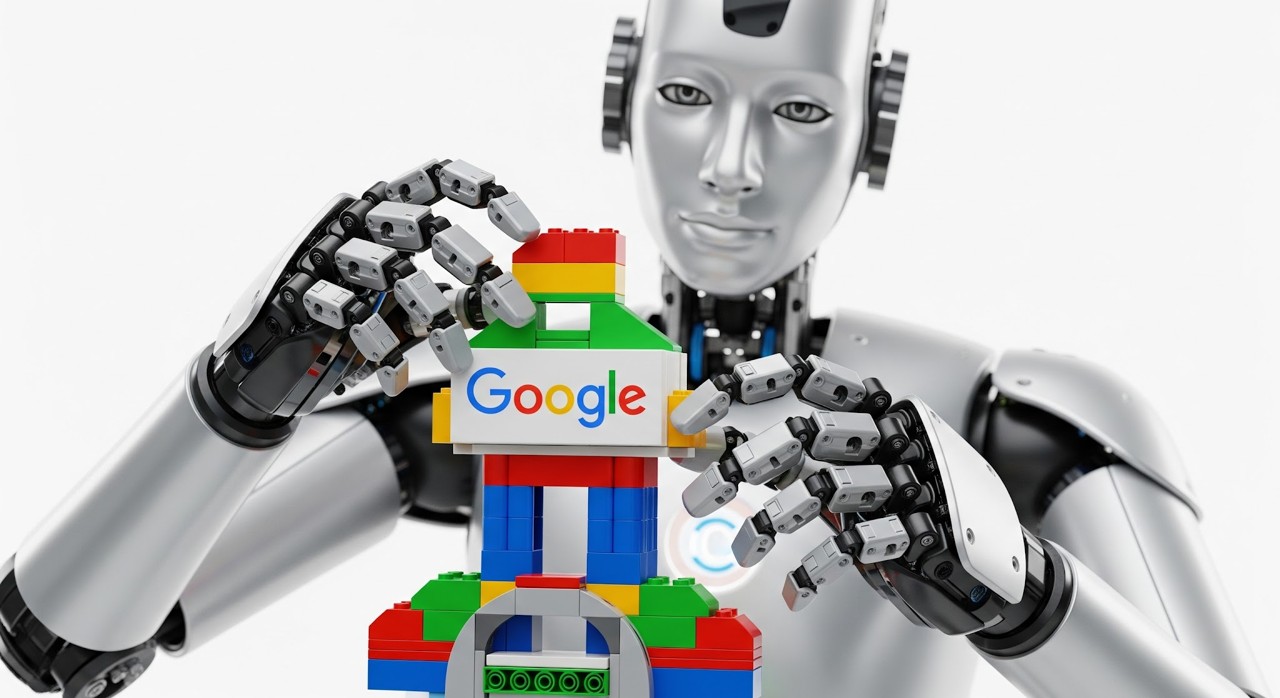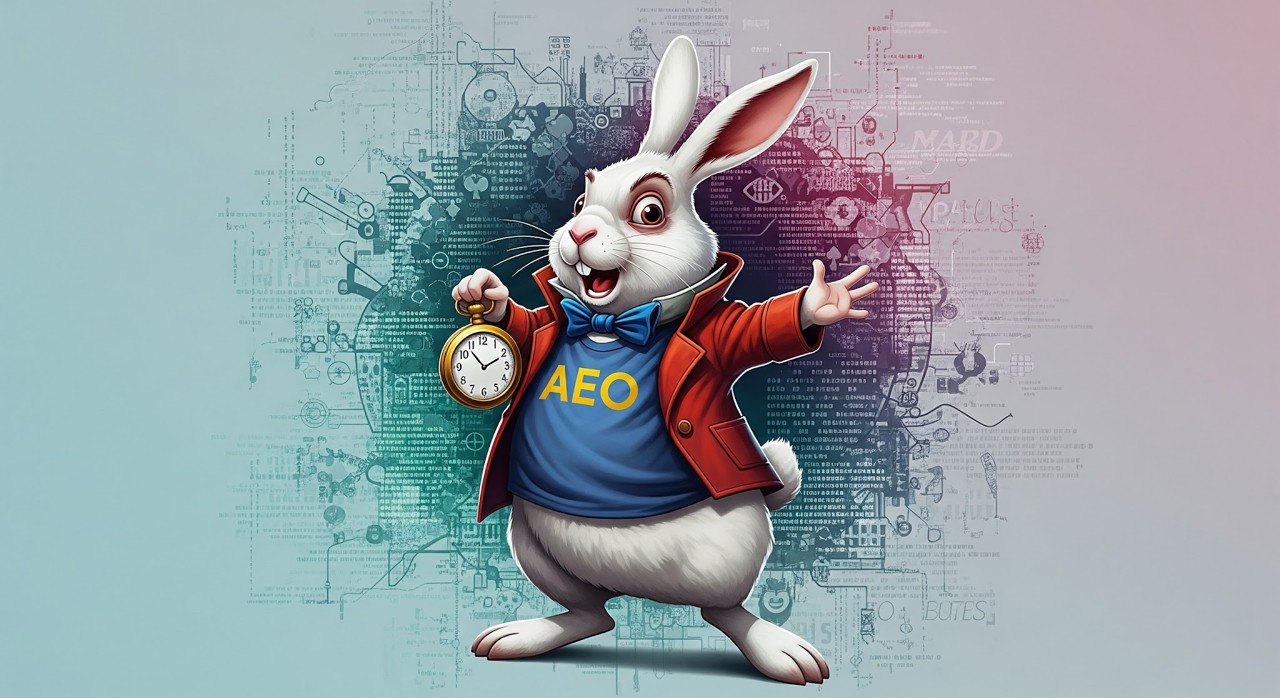13 min to read
By Bruno Gavino, CEO, Codedesign
For the better part of a decade, my conversations with clients followed a familiar rhythm. We’d sit down, pull up the dashboards, and talk about the metrics that defined success in digital marketing: keyword rankings, organic traffic, click-through rates. It was a predictable, quantifiable world. Then, starting in late 2024 and accelerating dramatically into 2025, the data started telling a different story. The patterns we had built our strategies on, the very foundation of our reports, began to break.
This isn’t another incremental change in Google’s algorithm. This isn’t a new SERP feature to optimize for. This is a fundamental restructuring of how information is discovered, synthesized, and consumed online. The shift to AI-driven search, headlined by Google’s AI Overviews (AIOs), is the most significant disruption to our industry since the advent of the smartphone.
This article is not a fear-mongering piece about the “death of SEO.” It’s a clear-eyed, data-driven briefing for leaders—founders, senior marketers, and my peers in the agency world. My goal is to walk you through what the data is really telling us about the impact of AI on search, why your old dashboards are now dangerously misleading, and what the new playbook for winning looks like. The game is no longer about chasing rankings. It’s about earning AI’s trust. And for many, the race to do so started months ago.

The Tipping Point Is in the Rear-View Mirror: A Sober Look at the Data
The debate about if AI will change search is over. The data shows it already has, and the pace of this transformation is breathtaking. To ignore the numbers now is to willingly fly blind into a storm. These statistics are not abstract figures; they are leading indicators of a permanent market shift that is already impacting your bottom line, whether you’ve realized it yet or not.
AI Overviews Aren't a Feature, They're the New Default
For months, the industry has been fixated on a single question: how prevalent are AI Overviews? The answers vary wildly, creating a "prevalence paradox" that can be misleading. In March 2025, Semrush reported that AIOs were triggered in about 13% of all queries. Yet by June 2025, other analyses citing data from Advanced Web Ranking claimed the figure had skyrocketed past 50% , while a study from SE Ranking placed it around 30%.
The variance is likely due to different methodologies, keyword sets, and the sheer velocity of Google's rollout. But focusing on the exact percentage misses the point entirely. The trend is what matters, and it is unambiguous and exponential. The Semrush data, for instance, showed a 102% surge in AIO prevalence in just two months, from January to March 2025. Xponent21 noted a doubling in the appearance rate between August 2024 and June 2025. The projection that AI would overtake traditional search by 2027 has collapsed; by some estimates, we are already two years ahead of that schedule.
The strategic takeaway is this: for a significant and rapidly growing portion of queries—especially the informational, top-of-funnel questions that initiate most customer journeys—the user experience has fundamentally changed. We must operate as if AI Overviews are the default, because for many of our target queries, they already are. This is no longer an experiment; it’s the new infrastructure of search.

The Great Traffic Heist: How AI Is Rerouting Your Audience
This is where the disruption becomes tangible for most businesses. The data on traffic loss is stark. A BrightEdge report revealed that while search impressions have gone up, click-through rates (CTR) have plummeted by 30% year-over-year. Multiple studies confirm that the CTR for the coveted #1 organic position can fall by over 34% when an AIO is present on the page.
The case of Mail Online provides a chillingly specific example. The publisher reported a 56.1% lower CTR on desktop when an AIO appeared above their #1 ranking. For one specific news-related keyword, traffic cratered from 6,000 clicks to just 100 after an AIO was introduced. Similarly, NerdWallet’s CEO acknowledged the impact on traffic to their non-commercial, educational pages.
The immediate reaction to these numbers is often panic. However, a more nuanced picture emerges when we look closer. Some early data suggests that while overall traffic volume is down, the quality of the traffic that does click through from an AIO citation may be significantly higher. One analysis found that traffic from AI-generated summaries converted better than traffic from traditional organic links. Another study by Terakeet discovered that for transactional queries, being included in an AIO actually boosted clicks by 3.2 times for top-ranked pages.
This points to a bifurcation of search traffic. AI Overviews are acting as a powerful filter. For simple, factual queries (e.g., “how much juice is in a lemon?”), they satisfy user intent directly on the SERP, creating zero-click searches and cannibalizing low-value traffic that was unlikely to convert anyway. But for more complex or high-intent queries, being cited in an AIO serves as a powerful endorsement. The user who reads a detailed AI summary and then clicks a source link is not a casual browser. They are a deeply engaged, highly qualified prospect who is actively seeking more depth and validation.
AI isn't just stealing your traffic; it's re-allocating it. It is absorbing the broad, low-value clicks at the top of the funnel, leading to an overall drop in volume. But for the brands that earn a citation, it delivers a smaller, more concentrated stream of "super-qualified" users. This forces a strategic pivot from a volume-based SEO model to a value-based one. The key metric is no longer the total number of clicks lost, but the conversion rate of the high-intent clicks you gain.

Google's Walled Garden Just Got Taller
This rerouting of user attention is happening within an ecosystem that is becoming increasingly self-contained. Research shows that Google links back to its own properties in 43% of AI Overviews. This, combined with data indicating that users now make an average of 10 clicks within Google before ever visiting an external website, paints a clear picture. Google's strategy is to satisfy user intent within its own walls, and AI is the most powerful tool it has ever deployed to achieve that goal.
This means the Search Engine Results Page (SERP) is no longer just a list of destinations; it is the destination itself. Your presence in an AI Overview, a "People Also Ask" box, or a Knowledge Panel is no longer merely a pathway to a click. For a growing number of users, it is the brand impression. This elevates the strategic importance of what has been called "zero-click marketing". Success is not just about driving a visit; it's about shaping the user's perception and providing the definitive answer directly on the results page. Your content's new job is to make your brand synonymous with the solution, even if the user never reaches your homepage. This is a profound evolution from driving traffic to influencing thought.
The Crisis in Measurement in the New AI-First World
The most immediate and dangerous consequence of this seismic shift is the obsolescence of our measurement frameworks. The tools and metrics we have relied on for years to gauge performance, justify budgets, and make strategic decisions are now broken. Navigating this new landscape with an old dashboard is like trying to fly a commercial airliner with a faulty altimeter and a compass that spins in circles. The companies that recognize this crisis and build a new intelligence stack first will gain an almost unfair advantage over those who continue to trust their lying eyes.

When "Organic" Becomes "Direct": The Attribution Black Hole
The measurement crisis first became apparent with a technical glitch that sent ripples through the analytics community. For a period, clicks originating from Google's new AI Mode were being misclassified as "Direct" traffic in Google Analytics and other platforms. This was caused by a rel="noopener noreferrer" attribute that Google was adding to the links, which stripped the referral data. Marketers saw their organic traffic inexplicably drop while direct traffic spiked, creating chaos in their reporting.
While Google eventually acknowledged and fixed this specific bug , it exposed a much larger and more persistent problem: a fundamental lack of clear, out-of-the-box attribution for this new class of search traffic. To this day, Google Search Console (GSC), the primary source of truth for most SEO teams, does not offer dedicated reporting for traffic originating from AI Mode or AI Overviews.
This creates a "fog of war" for marketers. Without reliable data, it becomes nearly impossible to measure the ROI of efforts aimed at optimizing for AI search, making it difficult to secure budget and prove value. This isn't just a technical challenge; it's a strategic one. The organizations that can move beyond default reports and build a more sophisticated, multi-source intelligence model will be able to navigate the fog while their competitors are paralyzed by uncertainty. The new competitive advantage in analytics lies in the ability to correlate disparate datasets—blending the murky data from GSC and GA with signals from brand mention tracking tools, sentiment analysis, and SERP feature monitoring. The winner will be the one who can assemble a coherent picture from fragmented signals, proving the value of their AI-focused strategy while others can only point to confusing and unreliable dashboards.
Your Old KPIs Are Lying to You: Redefining Success for 2025
If our tools are struggling to keep up, it follows that our Key Performance Indicators (KPIs) are in desperate need of an overhaul. Legacy metrics like keyword rankings, organic sessions, and even CTR are rapidly becoming vanity metrics in the AIO era. They no longer accurately reflect the reality of how brands gain visibility and influence audiences. A #1 ranking is meaningless if an AIO sits above it and absorbs all the clicks. A drop in organic sessions might be a sign of failure, or it might mean that AIOs are successfully filtering out low-intent traffic.
We need a new scorecard. The real metrics of success are now about influence, authority, and being the source of truth for the AI—not just about generating traffic.
|
Legacy KPI (Pre-AI) |
Why It's Failing in the AI Era |
The New AI-Native KPI |
How to Track It |
|
Keyword Rankings |
Your page can rank #1 but get zero clicks if an AIO answers the query. Position is no longer a proxy for visibility. |
AI Presence & Citation Count |
Manually checking SERPs and using emerging tools like Semrush AI Toolkit, Profound, or Ahrefs Brand Radar to track mentions in AIOs and other LLMs. |
|
Organic Sessions |
Declining due to zero-click searches and AIOs cannibalizing traffic. A drop in sessions is no longer a clear signal of failure. |
Branded Search Volume & Growth |
Tracking branded query volume in GSC and Google Trends. A spike after a campaign indicates successful "zero-click" brand building and growing mindshare. |
|
Click-Through Rate (CTR) |
Rendered unreliable by AIOs pushing organic results down the page and the ongoing attribution challenges. |
Share of SERP / Zero-Click Surface Presence |
Tracking how much SERP real estate you own (AIO citations, People Also Ask, snippets, video carousels). It's about total visibility, not just clicks. |
|
Backlink Count |
Still a signal of authority, but its correlation with AIO visibility is weaker than brand factors. A purely quantitative approach is outdated. |
Brand Authority & Unlinked Mentions |
Monitoring brand mentions across the web (Reddit, forums, news). These are strong signals for E-E-A-T that influence AI models. |
|
Page-Level Conversions |
Last-click attribution is dead. A user may see you in an AIO, research on another platform, and convert via a branded search days later. |
Assisted Conversions & Conversion Influence |
Using GA4's multi-touch attribution models to understand SEO's role at the start of the journey, not just the end. |
|
(New Category) |
N/A |
Chunk Retrieval Frequency & Embedding Relevance |
For advanced teams: Using technical tools like LangChain to simulate how often your content "chunks" are retrieved by RAG systems. |
"Position AI": How to Become the Source
Panic is not a strategy. While the ground is shifting, the new rules of the game are emerging, and they are learnable. The core challenge is no longer about tricking an algorithm into ranking a webpage. It's about systematically demonstrating your authority and structuring your content in a way that makes you the most reliable and useful source for the AI to learn from. This section provides the strategic and tactical shifts required to move from being a victim of this change to a beneficiary.
It's Not SEO, It's AEO: Shifting from Ranking Pages to Feeding Models
We did not became a TOP AEP Marketing agency by panic. The first and most critical shift is a mental one. We must move from Search Engine Optimization (SEO) to what is being called Answer Engine Optimization (AEO) or Generative Engine Optimization (GEO). The goal is no longer to rank a URL in a list of ten blue links. The goal is to have your content selected, deconstructed, and synthesized by an AI model to form part of a direct answer. This requires a fundamental change in perspective from "page-first" to "answer-first".
Think of your brand's entire digital presence as an API for artificial intelligence. AI models like Google's Gemini need to retrieve information to answer user queries. In essence, they are making an API call to the vast database of the web. Your brand's ecosystem—your website, blog, YouTube channel, structured data, third-party reviews, and forum mentions—functions as a single, comprehensive data source for that API.

Deconstruct Your Content: The Power of Modular, Answer-First Design
This analogy reframes every marketing activity. Content creation becomes about populating your API with high-quality, accurate data points. Technical SEO becomes the act of writing the API documentation (via schema markup) so the AI knows what each "endpoint" (piece of content) does and what kind of data it contains. PR and community management become about generating third-party validation that increases your API's overall trust score. You are no longer just building a website; you are building a queryable, machine-readable knowledge base.
AI Overviews do not rank pages; they extract and assemble content blocks. This means our approach to content creation must be deconstructed. We need to build content like LEGOs: a collection of individual, self-contained modules that can stand on their own but can also be snapped together to form a larger, cohesive whole.
-
Structure with Questions: Use clear, question-based headings (H2s and H3s) that mirror real user queries. This makes it easy for the AI to map a user's question to a specific section of your content.
-
Provide Direct Answers: Immediately following each question-based heading, provide a short, concise, and direct answer. This "answer block" is prime material for being extracted into an AIO.
-
Use AI-Friendly Formatting: Employ bullet points, numbered lists, tables, and pull quotes to break up text and present information in a structured, easily parsable format.
-
Create "Ultimate Guides": Instead of writing five separate blog posts on a topic, create a single, comprehensive "ultimate guide" built with modular blocks. For example, a guide to home EV chargers could have separate, self-contained modules for "What is a home EV charger?", "Types of chargers (comparison table)," "How installation works (step-by-step)," and "Book an assessment (CTA)". This allows a single page to serve multiple user intents, from top-of-funnel awareness to bottom-of-funnel conversion.
The actionable first step is to audit your highest-performing content. Identify the core questions each piece answers and restructure it into logical, answer-first modules. For all new content, begin with a "TL;DR" or summary block at the very top, explicitly designed for easy extraction. This same logic applies to product and service pages; embedding on-page FAQs that address common buyer questions can turn a commercial page into a valuable source for AIOs.

Schema and Semantics: Speaking the Language of AI
If modular content is about structuring your information for clarity, then structured data (implemented via Schema.org) is the technical layer that translates that structure into a language machines can fluently understand. In the AEO era, schema is no longer a "nice-to-have" or an advanced tactic for securing rich snippets; it is a non-negotiable, foundational requirement.
Without schema, an AI model has to infer the context of your content. It has to guess that "Bruno" refers to a person, that "Codedesign" is an organization, and that a string of numbers is a price. Schema removes the guesswork. By using specific schema types like Article, FAQPage, HowTo, Product, or Review, you are explicitly defining the entities on your page and the relationships between them. This is the Rosetta Stone for your brand's API. It dramatically reduces the cognitive load on the AI and increases the probability that your content will be understood, trusted, and used correctly.
The most advanced strategies go beyond marking up individual pages and focus on creating a connected knowledge graph for the entire site, where entities are linked and their relationships are clearly defined. This is a direct investment in the long-term "crawlability" and "usability" of your brand by all current and future AI systems. It is future-proofing your content at its most fundamental level.
The Unfair Advantage: Why Your Brand Is Your Most Powerful SEO Asset
For years, SEO has been dominated by a focus on technical factors and backlinks. While those elements still matter, the rise of AI search has elevated a new factor above all others: brand authority. Compelling research from Ahrefs has shown that off-site brand factors have the strongest correlation with being mentioned in AI Overviews. Branded web mentions (with a 0.664 correlation) and branded anchor text (0.527) are far more influential than traditional link metrics like Domain Rating. This aligns perfectly with the idea that AI search prioritizes brand authority above all else.
This shift transforms the abstract concept of E-E-A-T (Experience, Expertise, Authoritativeness, Trustworthiness) into a set of measurable, technical signals. An AI can't "feel" your trustworthiness; it has to calculate it based on data. It does this by:
-
Counting your brand mentions across the web.
-
Analyzing the authority of the sites that mention you.
-
Tracking the volume of users searching directly for your brand name.
-
Identifying author expertise through linked profiles and consistent topical coverage.
The strategic implication is monumental: your PR, social media, and content marketing strategies are now direct inputs into your technical search performance. Every unlinked mention on Reddit, every podcast interview where your CEO is cited as an expert, every guest post on a reputable industry site contributes to a vast corpus of data that validates your brand's authority to the AI. The silo between "brand marketing" and "performance marketing" has officially crumbled. In the AI era, your brand is your performance.

A Final, Candid Word: Are You Already Too Late?
This brings us to the provocative question at the heart of this discussion: is it already too late to pivot? The honest answer is: maybe.
There is a powerful first-mover advantage at play in AI search. Generative engines are built on trust, and trust is self-reinforcing. The sources that are cited early and often become, by definition, more trustworthy in the eyes of the model, leading to even more citations in the future. We are already seeing this dynamic play out. In sensitive "Your Money, Your Life" (YMYL) categories, authoritative brands like Healthline and NerdWallet have established a strong presence in AI Overviews, building a competitive moat that will become increasingly difficult for latecomers to cross.
However, the game is still in its early . The technology is volatile, and Google is constantly tuning its algorithms, sometimes scaling back AIOs in response to public criticism over accuracy. This volatility creates openings. There is still a window of opportunity for brands that act decisively now, but that window is closing fast. The cost and effort required to catch up will only increase exponentially over time. Inaction is the only strategy that guarantees you will be left behind.
Conclusion: Stop Chasing Links, Start Building Trust
The landscape of digital marketing has been irrevocably altered. The paradigm has shifted from a search engine that provides a list of links to an answer engine that provides a direct synthesis of information. This change has broken our traditional traffic patterns, invalidated our legacy measurement models, and demanded a new strategic approach.
The new imperative is to transform your brand from a collection of webpages into a trusted, authoritative, and machine-readable source of truth. This is not about finding a clever loophole or a new technical trick. It is about a fundamental commitment to quality, clarity, and authority.
The work starts now. Audit your content for modularity and answer-first design. Double down on your schema implementation to create a rich, connected knowledge graph. Realign your marketing teams to understand that building brand authority through PR, expert content, and community engagement is the new SEO. The future of search will not be won by those who are best at chasing links, but by those who are best at building trust. Let's get to work.
For a deeper dive into structuring your content reach out to our team at https://codedesign.org/contact-codedesign/
Bruno Gavino leads Codedesign, a global digital marketing agency helping companies scale demand with balanced, data-driven strategies.
 |
Thoughts by Bruno GavinoBruno Gavino is the CEO of Codedesign, a Lisbon-based digital marketing agency, with offices in Boston, Singapore, and Manchester (UK). He plays a pivotal role in shaping the agency’s growth and direction, particularly in the realm of digital marketing. Codedesign has built a strong team of dedicated professionals, including marketers, developers, and creative thinkers, with a mission to help businesses grow online. Bruno’s expertise extends to various aspects of digital marketing, and he has been active in sharing his insights on the impact of significant global events on the digital marketing landscape. His contributions to the field extend beyond his role at Codedesign. Bruno Gavino is known for his broad perspective on digital strategies and innovative solutions that drive the company’s vision. |
 |
CodedesignCodedesign is a digital marketing agency with a strong multicultural and international presence, offering expert services in digital marketing. Our digital agency in Lisbon, Boston, and Manchester enables us to provide market-ready strategies that suit a wide range of clients across the globe (both B2B and B2C). We specialize in creating impactful online experiences, focusing on making your digital presence strong and efficient. Our approach is straightforward and effective, ensuring that every client receives a personalized service that truly meets their needs. Our digital agency is committed to using the latest data and technology to help your business stand out. Whether you’re looking to increase your online visibility, connect better with your audience, get more leads, or grow your online sales. For more information, read our Digital Strategy Blog or to start your journey with us, please feel free to contact us. |
CodeDesign is leading:
– Digital Agency
– Digital Marketing Agency
– AI Marketing Ageency



Add comment ×